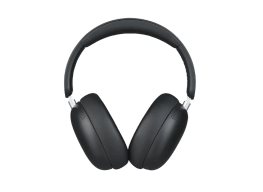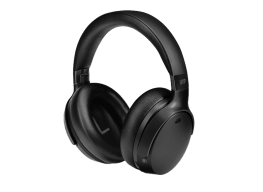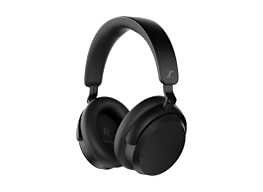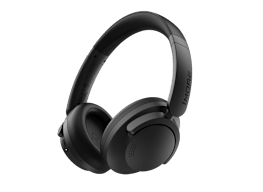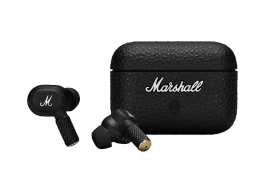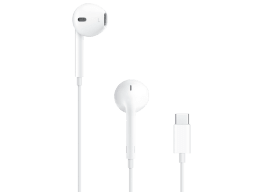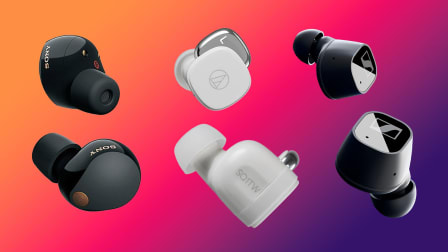True Wireless Earphones Face-Off: Apple AirPods vs. Samsung Galaxy Buds
Sound-quality testing in CR's labs reveal a clear winner
When you shop through retailer links on our site, we may earn affiliate commissions. 100% of the fees we collect are used to support our nonprofit mission. Learn more.
Apple AirPods are among the best-selling earphones of all time. They’re simple to use, sync easily with other Apple products, and come with appealing features. But despite their overwhelming success, our tests show that they come up short in the area that counts above all else: They just don’t sound great.
Consumer Reports tests dozens of headphones every year, and we’ve found a variety of true wireless earphones—those with no physical connection between the two earpieces—that deliver better sound quality. In our latest round of tests, though, a new model raises the bar.
Sound Quality
The AirPods do a decent job of reproducing music and movie dialog, and while they’re a reasonable choice for casual use, they have some obvious shortcomings when you listen with a critical ear.
One weak spot is bass. The AirPods deliver the physical thump you get from percussive low sounds like a kick drum, but the earphones lack depth. Think of the acoustic bass on Miles Davis' "So What." The bass is there, but you miss the round, satisfying rumble of the low notes. The midrange has problems as well. Passages with a lot of instruments blur together for a congested feel, making it more difficult to pick out individual sounds.
And while the treble is detailed overall, some delicate high sounds, like the vibrating hiss of a cymbal, come out smeared. In fact, our testers say the AirPods’ audio is nearly identical to that of the $30 wired earbuds that used to come free with Apple iPhones.
The AirPods don’t sound terrible—far from it. But when you listen back-to-back with the Samsung Galaxy Buds, the difference is undeniable. You don’t have to be an audio snob to hear it.
No headphones are perfect, but the Galaxy Buds’ flaws are minor. The bass is a touch prominent, but it has an obvious depth the AirPods lack, and the mids and highs are significantly better as well. The Galaxy Buds highlight nuance across the audio spectrum for playback that’s significantly clearer and more dynamic than what the AirPods can produce.
Form and Fit
The differences in design between the two models are more than just aesthetic. They affect performance.
The AirPods rest in the bowl of your ear without creating a seal. That’s an intentional choice on Apple’s part. It lets in sound from the outside environment, helping you feel more connected to your surroundings. But at times it can also make it hard to hear your audio. On busy streets, for example, I needed to turn the volume up to an uncomfortable level to understand podcasts, a bad practice given the threat headphones pose to your hearing.
The Samsung Galaxy Buds use tips you insert into the openings of your ear canals, a design that does a far better job at isolating you from ambient noise. That makes it easier to listen at safer volumes without sacrificing clarity. But having your ears plugged up can make you feel cut off from the outside world, creating other hazards, especially amid the bustle of city streets.
Most users will probably find that the Galaxy Buds stay in place without any problems, and they come with silicone wings that hug the inside of your ear for an even more secure fit. Still, ear-insert tips can be uncomfortable for some people. That's all relative, of course. For me, AirPods are easier to keep in for long periods of time, but others I know find them less pleasant.
Features
With true wireless earphones, the carrying case matters. Because they're small, the eapieces tend to have a limited battery life, and to make up for that, they're generally housed in a case with a built-in battery that doubles as a portable charger.
The AirPods are advertised for 5 hours of music playback, and the case is supposed to hold enough juice to power the earphones for four full charges. According to Samsung, the Galaxy Buds are good for 6 hours of music playback, but the case holds only a little over one full charge (7 extra hours of battery life, total). Consumer Reports doesn’t test battery life in headphones, but both claims held true in my informal trial.
That means AirPod users likely won’t need to charge the case as often, but the Galaxy Buds have the edge for longer, uninterrupted playback. Both models have a quick-charge function that takes just 15 minutes to provide more than an hour of listening.
The AirPods case is the smallest of any true wireless earphones I’ve used. The Galaxy Buds case is smaller than average, but a bit thicker than the AirPods' case. Both are small enough to slide into a pocket.
Samsung has a clear advantage in wireless charging. The feature, which lets users who own a wireless charging pad power the headphones without plugging in a cord, comes standard with the Galaxy Buds. Apple introduced the feature with the second generation AirPods launched last April, but you have to pay extra for a compatible case.
When you plug in the carrying cases, the Buds' charging port uses USB-C, which may be more convenient than the AirPods' Lightning port for some people.
The second generation AirPods have another update worth mentioning. Apple says its company-designed H1 chip improves call quality. Again, CR’s focus with headphones is sound quality, and we don’t test calls in the lab. But in a quick trial around the office, the AirPods sounded much better for the person on the other end of the line than the Galaxy Buds did. They did a better job at cutting down on background noise, too.
Controls and Triggers
Both models use tap controls. On the Buds, tap once to play or pause, twice to skip forward or answer calls, and three times to skip back. Tap and hold to decline calls and trigger digital assistants. If you own an Android phone, you can use a free companion app to change the tap-and-hold feature, using it to adjust the volume or trigger an ambient sound-monitoring mode, which amplifies noise from your surroundings.
The AirPods controls are more limited. By default, you can double tap to start playback, and double tap again to skip to the next track. If you pair the AirPods with an Android device, that’s all you get—unless you use a third-party app to change the controls. You can’t pause, skip backward, or do anything without picking up your phone. On Apple devices, you can change the controls with ease, but you're still limited to a single control for each earbud. It's up to you whether you want to activate Siri, play, pause, or skip tracks forward or back. You can control volume using Siri, but there's no option to adjust it using a touch or a tap.
With the second generation AirPods, you can call up Siri on an Apple device using your voice, but they can't use voice-activation for assistants on Andoid. The Buds’ other controls work as well on Apple as they do on Android, but there’s no companion app on Apple devices to adjust what the controls do.
Apple deserves a lot of credit for how easy it is to pair the AirPods with the company's other devices. Open the AirPods case near an Apple device for the first time and the device will automatically open a pairing dialog. Pair the headphones once and they will automatically be paired with every other device using the same Apple account. The Galaxy Buds work almost as seamlessly with Samsung Galaxy phones. However, pairing either product with devices made by other manufacturers is no different than it is with headphones made by other manufacturers.
Open the case on either product, and the earphones will automatically connect to any paired device. (Most true wireless earphones work that way, in fact.) Both models also have a handy feature that will pause playback automatically when you take the headphones out of your ears. But with the AirPods, that only works on Apple products, while the Buds do it no matter what.
The Bottom Line
The AirPods didn't score well enough in our tests to earn a Consumer Reports recommendation, but many people will find the sound perfectly acceptable. And the AirPods have a convenient case, work really well for phone calls, and make life easy for Apple users. But the controls are disappointing when you're using Android devices, and less functional than Galaxy Buds' controls in general.
Next year, Apple may unveil a new version of the AirPods, which will reportedly add noise-cancelling—and a higher price. If and when they hit the market, we’ll get them in the Consumer Reports labs and put them to the test. But for now, the Samsung Galaxy Buds get the nod.
The Galaxy Buds sound fantastic, well beyond what you hear with your average headphones. They come standard with modern features like USB-C and wireless charging compatibility, and you don’t need to blast the volume to hear over your surroundings. In general, they work better on iPhones than the AirPods do on Android devices.
Some people might prefer the AirPods, but if you want performance, our tests show that the Samsung Galaxy Buds are among the best true wireless headphones on the market.
How to Choose Headphones
With so many types of headphones, how do you know which pair is right for you? On the "Consumer 101" TV show, Consumer Reports expert Elias Arias explains everything you need to know.



















